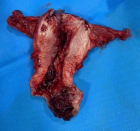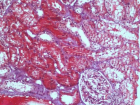Abstract
Review Article
Photocatalytic Degradation of Microcystins-LR over Mesoporous graphitic Carbon Nitride (mpg-CN)
Laiyan Wu*, Jirong Lan, Anping Yang, Yanxi Zhao, Songbo Wang and Junjiang Zhu*
Published: 24 May, 2017 | Volume 1 - Issue 1 | Pages: 012-22
Mesoporous graphitic carbon nitrides (mpg-CN) were synthesized by a templating method using Ludox (SiO2) as hard template and guanidine hydrochloride (GndCl) as precursor, and were used as metal-free photocatalysts for microcystin-LR (MC-LR) degradation in aqueous solution. By tuning the mass ratio of SiO2 to GndCl, mpg-CN with varied surface areas and condensation degrees were obtained. Catalytic results showed that sample prepared at mass ratio equals 0.4, i.e., mpg-CN(0.4), exhibits the best activity, with above 98% MC-LR conversion obtained at 120 min. Mechanism studies suggested that the reaction obeys the pseudo first-order equation and the produced superoxide anion radicals (•O2−) is the major reactive intermediates contributing to the reaction. Stability tests showed that no appreciable loss of activity is observed even the catalyst is recycled for five times, indicating that the material is stable in the reaction.
Read Full Article HTML DOI: 10.29328/journal.aac.1001002 Cite this Article Read Full Article PDF
Keywords:
Mpg-CN; Microcystin-LR; Photo degradation; Reusability; Mechanism
References
- Carmichael WW, Azevedo SM, An JS, Molica RJ, Jochimsen EM, et al. Human fatalities from cyanobacteria: Chemical and biological evidence for cyanotoxins. Environ Health Persp. 2001; 109: 663-668. Ref.: https://goo.gl/STlMcB
- Chen J, Xie P, Li L, Xu J. First identification of the hepatotoxic microcystins in the serum of a chronically exposed human population together with indication of hepatocellular damage. Toxicol Sci. 2009; 108: 81-89. Ref.: https://goo.gl/mVlHbz
- Dietrich D, Hoeger S. Guidance values for microcystins in water and cyanobacterial supplement products (blue-green algal supplements): A reasonable or misguided approach? Toxicol Appl Pharm. 2005; 203: 273-289. Ref.: https://goo.gl/Vp8cNV
- Falconer I, Bartram J, Chorus I, Kuiper-Goodman T, Utkilen H, et al. Safe levels and safe practices. In: Chorus i, bartram j (eds) toxic cyanobacteria in water-a guide to their public health consequences, monitoring and management. Published: E & FN Spon, 1999: 155-178.
- Tsuji K, Naito S, Kondo F, Ishikawa N, Watanabe MF, et al. Stability of microcystins from cyanobacteria: Effect of light on decomposition and isomerization. Environ Sci Technol. 1994; 28: 173-177. Ref.: https://goo.gl/MZX9im
- Harada K, Tsuji K, Watanabe MF, Kondo F. Stability of microcystins from cyanobacteria-iii. Effect of pH and temperature. Phycologia. 1996; 35: 83-88. Ref.: https://goo.gl/zwxaoN
- Miao H, Tao W. The mechanisms of ozonation on cyanobacteria and its toxins removal. Sep Purif Technol. 2009; 66: 187-193. Ref.: https://goo.gl/a6tsD4
- Pelaez M, Falaras P, Likodimos V, Kontos AG, de la Cruz KO AA, et al. Synthesis, structural characterization and evaluation of sol-gel-based NF-TiO2 films with visible light-photoactivation for the removal of microcystin-LR. Appl Catal B: Environ. 2010; 99: 378-387. Ref.: https://goo.gl/IfULFj
- Ho L, Onstad G, Von Guntern U, Rinck-Pfeiffer S, Craig K, et al. Differences in the chlorine reactivity of four microcystin analogues. Water Res. 2006; 40: 1200-1209. Ref.: https://goo.gl/ym7KE0
- Fotiou T, Triantis TM, Kaloudis T, Hiskia A. Evaluation of the photocatalytic activity of TiO2 based catalysts for the degradation and mineralization of cyanobacterial toxins and water off-odor compounds under UV-a, solar and visible light. Chem Eng J. 2015; 261: 17-26. Ref.: https://goo.gl/fiQaWU
- Andersen J, Han C, O’Shea K, Dionysiou DD. Revealing the degradation intermediates and pathways of visible light-induced NF-TiO2 photocatalysis of microcystin-LR. Appl Catal B: Environ. 2014; 154-155: 259-266. Ref.: https://goo.gl/S0riEM
- Vilela WFD, Minillo A, Rocha O, Vieira EM, Azevedo EB. Degradation of [D-Leu]-microcystin-LR by solar heterogeneous photocatalysis (TiO2). Sol Energy. 2012; 86: 2746-2752.
- Lawton LA, Robertson PKJ, Cornish BJPA, Jaspars M. Detoxification of microcystins (cyanobacterial hepatotoxins) using TiO2 photocatalytic oxidation. Environ Sci Technol. 1999; 33: 771-775. Ref.: https://goo.gl/kdc3YC
- Liu I, Lawton LA, Robertson PK. Mechanistic studies of the photocatalytic oxidation of microcystin-LR: An investigation of byproducts of the decomposition process. Environ Sci Technol. 2003; 37: 3214-3219. Ref.: https://goo.gl/RcQo96
- Wang XC, Maeda K, Thomas A, Takanabe K, Xin G, et al. Nat Mater, A metal-free polymeric photocatalyst for hydrogen production from water under visible light. 2009; 8: 76-80. Ref.: https://goo.gl/y7PFGV
- Wang XC, Blechert S, Antonietti M. Polymeric graphitic carbon nitride for heterogeneous photocatalysis. ACS Catal. 2012; 2: 1596-1606. Ref.: https://goo.gl/aF8l4X
- Xiang Q, Yu J, Jaroniec M. Preparation and enhanced visible-light photocatalytic H2-production activity of graphene/C3N4 composites. J Phys Chem C. 2011; 115: 7355-7363. Ref.: https://goo.gl/b1vZO7
- Wang Y, Wang X, Antonietti M. Polymeric graphitic carbon nitride as a heterogeneous organocatalyst: From photochemistry to multipurpose catalysis to sustainable chemistry. Angew Chem Int Ed. 2012; 51: 68-89. Ref.: https://goo.gl/cfHKZS
- Su DS, Zhang J, Frank B, Thomas A, Wang XC, et al. Metal-free heterogeneous catalysis for sustainable chemistry. ChemSusChem. 2010; 3: 169-180. Ref.: https://goo.gl/cs3EJl
- Xu J, Wu H-T, Wang X, Xue B, Li Y-X, et al. A new and environmentally benign precursor for the synthesis of mesoporous g-C3N4 with tunable surface area. Phys Chem Chem Phys. 2013; 15: 4510-4517. Ref.: https://goo.gl/hp9Ns9
- Wang Y, Wang XC, Antonietti M, Zhang Y. Facile one-pot synthesis of nanoporous carbon nitride solids by using soft templates. Chemsuschem. 2010; 3: 435-439. Ref.: https://goo.gl/vR7PY4
- Wang XC, Maeda K, Chen X, Takanabe K, Domen K, et al. Polymer semiconductors for artificial photosynthesis: Hydrogen evolution by mesoporous graphitic carbon nitride with visible light. J Am Chem Soc. 2009; 131: 1680-1681. Ref.: https://goo.gl/cTDH1M
- Cui Y, Ding Z, Liu P, Antonietti M, Fu X, et al. Metal-free activation of H2O2 by g-C3N4 under visible light irradiation for the degradation of organic pollutants. Phys Chem Chem Phys. 2012; 14: 1455-1462. Ref.: https://goo.gl/47dvGf
- Xiao H, Zhu J, Thomas A. Graphitic carbon nitride for photocatalytic degradation of sulfamethazine in aqueous solution under simulated sunlight irradiation RSC Advances. 2015; 5: 105731-105734.
- Yang Q, Wang W, Zhao Y, Zhu J, Zhu Y, et al. Metal-free mesoporous carbon nitride catalyze the Friedel-Crafts reaction by activation of benzene. RSC Advances. 2015; 5: 54978-54984.
- Xiao H, Wang W, Liu G, Chen Z, Lv K, et al. Photocatalytic performances of g-C3N4 based catalysts for RhB degradation: Effect of preparation conditions. Appl Surf Sci. 2015; 358: 313-318. Ref.: https://goo.gl/A5097Z
- Parra S, Olivero J, Pulgarin C. Relationships between physicochemical properties and photoreactivity of four biorecalcitrant phenylurea herbicides in aqueous TiO2 suspension. Appl Catal B: Environ. 2002; 36: 75-85. Ref.: https://goo.gl/7fDSU0
- Malato S, Fernández-Ibáñez P, Maldonado MI, Blanco J, Gernjak W. Decontamination and disinfection of water by solar photocatalysis: Recent overview and trends. Catal Today. 2009; 147: 1-59. Ref.: https://goo.gl/YlBIsM
- Bouzaida I, Ferronato C, Chovelon JM, Rammah ME, Herrmann JM. Heterogeneous photocatalytic degradation of the anthraquinonic dye, Acid Blue 25 (AB25): a kinetic approach. J Photochem Photobiol A: Chem. 2004; 168: 23-30. Ref.: https://goo.gl/523gPm
- Tennakone K, Tilakaratne CTK, Kottegoda IRM. Photomineralization of carbofuran by TiO2-supported catalyst. Water Res. 1997; 31: 1909-1912. Ref.: https://goo.gl/WVw6oz
- T Fotiou, TM Triantis, T Kaloudis, Hiskia A. Evaluation of the photocatalytic activity of TiO2 based catalysts for the degradation and mineralization of cyanobacterial toxins and water off-odor compounds under uv-a, solar and visible light. Chem Eng J. 2015; 261: 17-26. Ref.: https://goo.gl/N8NvCn
- Izaguirre G, Jungblut AD, Neilan BA. Benthic cyanobacteria (Oscillatoriaceae) that produce microcystin-LR, isolated from four reservoirs in southern california. Water Res. 2007; 41: 492-498. Ref.: https://goo.gl/JR6QTC
- Wang Q, Niu Y, Xie P, Chen J, Ma Z, et al. Factors affecting temporal and spatial variations of microcystins in gonghu bay of lake taihu, with potential risk of microcystin contamination to human health. Sci World J. 2010; 10: 1795-1809. Ref.: https://goo.gl/wm1ZrK
- Wang X, Utsumi M, Yang YN, Li DW, Zhao YX, et al. Degradation of microcystin-LR by highly efficient AgBr/Ag3PO4/TiO2 heterojunction photocatalyst under simulated solar light irradiation. Appl Surf Sci. 2015; 325: 1-12. Ref.: https://goo.gl/NdqB7n
- Chen SF, Liu W, Zhang HY, Yu XL. Photocatalytic decolorization of soluble dyes by a bis-ions coexistence system of NH4+ and NO3− with high photoreduction ability. J Hazard Mater. 2011; 186: 1687-1695. Ref.: https://goo.gl/lpPsq7
- Minero C, Mariella G, Maurino V, Vione D, Pelizzetti E. Photocatalytic transformation of organic compounds in the presence of inorganic ions. 2. Competitive reactions of phenol and alcohols on a titanium dioxide-fluoride system. Langmuir. 2000; 16: 8964-8972. Ref.: https://goo.gl/sYwRHC
- Yin MC, Li ZS, Kou J, Zou Z. Mechanism investigation of visible light-induced degradation in a heterogeneous TiO2/eosiny/rhodamine B system. Environ Sci Technol. 2009; 43: 8361-8366. Ref.: https://goo.gl/nBh8DT
- Fang S, Lv KL, Li Q, Ye HP, Du DY, et al. Effect of acid on the photocatalytic degradation of rhodamine B over g-C3N4. Appl Surf Sci. 2015; 358: 336-342. Ref.: https://goo.gl/w364ca
- Yan SC, Li ZS, Zou ZG. Photodegradation performance of g-C3N4 fabricated by directly heating melamine. Langmuir. 2009; 25: 10397-10401. Ref.: https://goo.gl/O1jVlX
- Cui YJ, Huang JH, Fu XZ, Wang XC. Metal-free photocatalytic degradation of 4-chlorophenol in water by mesoporous carbon nitride semiconductors. Catal Sci Technol. 2012; 2: 1396-1402. Ref.: https://goo.gl/zoHfiC
Figures:

Figure 1
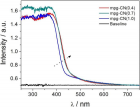
Figure 2

Figure 3

Figure 4

Figure 5
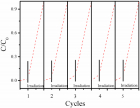
Figure 6

Figure 7
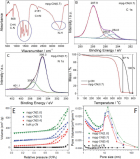
Figure 8
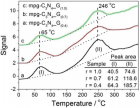
Figure 9
Similar Articles
-
Photocatalytic Degradation of Microcystins-LR over Mesoporous graphitic Carbon Nitride (mpg-CN)Laiyan Wu*,Jirong Lan,Anping Yang,Yanxi Zhao,Songbo Wang,Junjiang Zhu*. Photocatalytic Degradation of Microcystins-LR over Mesoporous graphitic Carbon Nitride (mpg-CN). . 2017 doi: 10.29328/journal.aac.1001002; 1: 012-22
-
Convenient route synthesis of some new benzothiazole derivatives and their pharmacological screening as antimicrobial agentsAhmed A Fadda*,Nanees N Soliman,Ahmed Fekri. Convenient route synthesis of some new benzothiazole derivatives and their pharmacological screening as antimicrobial agents. . 2017 doi: 10.29328/journal.aac.1001004; 1: 032-046
-
Impact of alloimmunization on transfusion-dependent patientsSurapon Tangvarasittichai*. Impact of alloimmunization on transfusion-dependent patients. . 2017 doi: 10.29328/journal.aac.1001009; 1: 070-082
-
Treatment of antibiotic-resistant bacteria by nanoparticles: Current approaches and prospectsTigabu Bekele*,Getachew Alamnie. Treatment of antibiotic-resistant bacteria by nanoparticles: Current approaches and prospects. . 2022 doi: 10.29328/journal.aac.1001025; 6: 001-009
-
Surface energy of micro- and nanowireSerghei A Baranov*. Surface energy of micro- and nanowire. . 2023 doi: 10.29328/journal.aac.1001039; 7: 025-030
-
Methodology for Studying Combustion of Solid Rocket Propellants using Artificial Neural NetworksVictor Abrukov*, Weiqiang Pang, Darya Anufrieva. Methodology for Studying Combustion of Solid Rocket Propellants using Artificial Neural Networks. . 2024 doi: 10.29328/journal.aac.1001048; 8: 001-007
-
Comparative Studies of Diclofenac Sodium (NSAID) Adsorption on Wheat (Triticum aestivum) Bran and Groundnut (Arachis hypogaea) Shell Powder using Vertical and Sequential Bed ColumnNeha Dhiman*. Comparative Studies of Diclofenac Sodium (NSAID) Adsorption on Wheat (Triticum aestivum) Bran and Groundnut (Arachis hypogaea) Shell Powder using Vertical and Sequential Bed Column. . 2024 doi: 10.29328/journal.aac.1001052; 8: 021-029
Recently Viewed
-
Prediction of neonatal and maternal index based on development and population indicators: a global ecological studySedigheh Abdollahpour,Hamid Heidarian Miri,Talat Khadivzadeh*. Prediction of neonatal and maternal index based on development and population indicators: a global ecological study. Clin J Obstet Gynecol. 2021: doi: 10.29328/journal.cjog.1001096; 4: 101-105
-
A Genetic study in assisted reproduction and the risk of congenital anomaliesKaparelioti Chrysoula,Koniari Eleni*,Efthymiou Vasiliki,Loutradis Dimitrios,Chrousos George,Fryssira Eleni. A Genetic study in assisted reproduction and the risk of congenital anomalies. Clin J Obstet Gynecol. 2021: doi: 10.29328/journal.cjog.1001095; 4: 096-100
-
Leiomyosarcoma in pregnancy: Incidental finding during routine caesarean sectionToon Wen Tang*,Phoon Wai Leng Jessie. Leiomyosarcoma in pregnancy: Incidental finding during routine caesarean section. Clin J Obstet Gynecol. 2021: doi: 10.29328/journal.cjog.1001094; 4: 092-095
-
Adult Neurogenesis: A Review of Current Perspectives and Implications for Neuroscience ResearchAlex, Gideon S*,Olanrewaju Oluwaseun Oke,Joy Wilberforce Ekokojde,Tolulope Judah Gbayisomore,Martina C. Anene-Ogbe,Farounbi Glory,Joshua Ayodele Yusuf. Adult Neurogenesis: A Review of Current Perspectives and Implications for Neuroscience Research. J Neurosci Neurol Disord. 2024: doi: 10.29328/journal.jnnd.1001102; 8: 106-114
-
Late discover of a traumatic cardiac injury: Case reportBenlafqih C,Bouhdadi H*,Bakkali A,Rhissassi J,Sayah R,Laaroussi M. Late discover of a traumatic cardiac injury: Case report. J Cardiol Cardiovasc Med. 2019: doi: 10.29328/journal.jccm.1001048; 4: 100-102
Most Viewed
-
Evaluation of Biostimulants Based on Recovered Protein Hydrolysates from Animal By-products as Plant Growth EnhancersH Pérez-Aguilar*, M Lacruz-Asaro, F Arán-Ais. Evaluation of Biostimulants Based on Recovered Protein Hydrolysates from Animal By-products as Plant Growth Enhancers. J Plant Sci Phytopathol. 2023 doi: 10.29328/journal.jpsp.1001104; 7: 042-047
-
Sinonasal Myxoma Extending into the Orbit in a 4-Year Old: A Case PresentationJulian A Purrinos*, Ramzi Younis. Sinonasal Myxoma Extending into the Orbit in a 4-Year Old: A Case Presentation. Arch Case Rep. 2024 doi: 10.29328/journal.acr.1001099; 8: 075-077
-
Feasibility study of magnetic sensing for detecting single-neuron action potentialsDenis Tonini,Kai Wu,Renata Saha,Jian-Ping Wang*. Feasibility study of magnetic sensing for detecting single-neuron action potentials. Ann Biomed Sci Eng. 2022 doi: 10.29328/journal.abse.1001018; 6: 019-029
-
Pediatric Dysgerminoma: Unveiling a Rare Ovarian TumorFaten Limaiem*, Khalil Saffar, Ahmed Halouani. Pediatric Dysgerminoma: Unveiling a Rare Ovarian Tumor. Arch Case Rep. 2024 doi: 10.29328/journal.acr.1001087; 8: 010-013
-
Physical activity can change the physiological and psychological circumstances during COVID-19 pandemic: A narrative reviewKhashayar Maroufi*. Physical activity can change the physiological and psychological circumstances during COVID-19 pandemic: A narrative review. J Sports Med Ther. 2021 doi: 10.29328/journal.jsmt.1001051; 6: 001-007

HSPI: We're glad you're here. Please click "create a new Query" if you are a new visitor to our website and need further information from us.
If you are already a member of our network and need to keep track of any developments regarding a question you have already submitted, click "take me to my Query."







